The Illiterate Engraver of Guanajuato
by William Sigl

There was such a rich assortment of engraving errors in the lower denominations from the Guanajuato mint during the period from 1828 to 184 that there is no equal in any other period of time anywhere in Mexican history. These are not your run of the mill varieties like overdates, over mintmarks, over assayers, double dies, or repunched letters. Varieties such as those do not even register on the scale of errors made between 1828 and 1834
in Guanajuato. These were spelling errors, and omission of a number. When a spelling error or a numerical error occurs on a coin, it is a major embarrassment to the mint and the country. Instances of these types of engraving errors are rare, even for world coins.
A series of major engraving errors occurred annually across the four smallest denominations of coins in Guanajuato.
Collectors have speculated for the past few decades about the reason for such a large number of major errors. The general consensus was attributed to alcoholism among employees of the mint. They were referred to as ‘Monday Morning Dies’, mistakes made by engravers that were hung over. I used to believe this, but analysis of the dies has led me to another conclusion.
If the cause of all these engraving errors was due to alcoholism, why were they all confined to the lowest denominations?
Why did such errors not occur on any 2 reales or 8 reales from Guanajuato during this time? Why were there no such errors on the gold issues from Guanajuato?
In this article I will identify most of the major spelling errors during this period, then provide strong evidence pointing to the likely cause being illiteracy on the part of one or more junior engravers.
Octavos and Quartillas
The Guanajuato mint struck 1/8 reales (known as Octavos), and 1/4 reales (known as Quartillas) in copper (and sometimes in brass). These were struck from 1828 thru 1830. It is unfortunate that the production of these state coppers was so short, but they were probably discontinued as more and more such coins were being struck in Mexico City. The design of these coins is absolutely stunning, if you are fortunate enough to obtain one in high grade. Unfortunately these coins usually come in Very Good to Fine condition, with lots of corrosion.
For the purposes of this article I will confine my focus to the reverse of these copper coins, since that is where the spelling errors occurred. A really good example of what a normal Octavo should look like is pictured below.
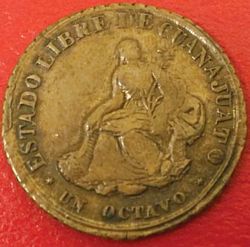
1828 Quartillo with ‘GUANJUATO’
The catalogs list a variety of the 1828 quartilla that has the ‘GUANAJUATO’ misspelled as ‘GUANJUATO’. Though listed in the catalogs, I do not have an example of this error, and I could not find another collector with such a coin in their collections. Though I do not have an example, I have no doubt that it exists.
1829 and 1830 Octavo Varieties
In 1829 there were two misspelling varieties produced for the octavo. The first is again ‘GUANAJUATO’ misspelled as ‘GUANJUATO’. A close-up of the section of the coin with the error appears at the top of the article. The error is easy to identify if you are aware of its existence, and are examining a coin that has all of its details intact. Here is the full coin to get a perspective of the error.
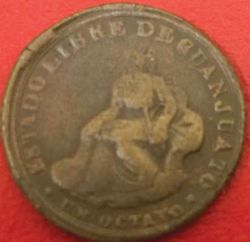
This same error also occurs in the 1830 octavos, but it appears to be much more Rare.
Another 1829 Octavo error has the ‘LIBRE’ misspelled as ‘LIBE’. State coppers are very challenging to find above Very Good condition, and this example that I have is in low grade, so I apologize for the lack of sharpness of the following image.
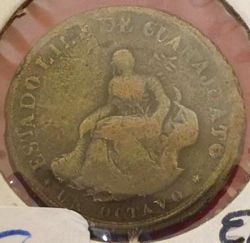
Several of these misspelling errors are not even listed in the major catalogs. This works in the favor of the informed collector, since it makes it more likely that you will be able to locate one. However the secret is not so much of a secret anymore, so you will have to start now, and be persistent in your searches for such spelling errors.
I cannot speak from experience on the rarity of the 1828 Quartilla misspelling error, but I suspect it is Rare. I feel that the ‘LIBE’ spelling error on the 1829 Octavo is at least Rare since it is not even included in the catalogs. The ‘GUANJUATO’ spelling error on the 1829 Octavo is Rare, and on the 1830 it may be Very Rare.
Half Real Retrograde ‘N’ variety
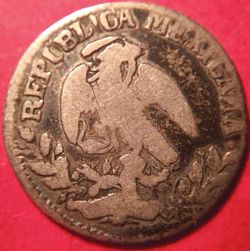
The next major error occurred in 1929 on the half real. The ‘N’ in ‘MEXICANA’ was retrograde, or reversed. This variety appears to be Rare. Most dealers have never handled one, and few collectors have one in their collection. The lettering on half reales is very small, so part of the problem may be that many people do not look closely enough at their small coins to spot this error. Look closely at 1829 half reales from Guanajuato that you encounter and you might find one. If you are lucky, it may not cost you much. Mine is a low grade example, but it cost me less than $50.
1829 Real with corrected Retrograde ‘N’

Reales from 1829 also have a reversed ‘N’ in ‘MEXICANA’, but it was corrected before any coins were minted with the error. All examples that I have found of this variety have a normal ‘N’ over the retrograde ‘N’. This variety is not listed in the catalogs, so I advise everyone to keep an eye out for it. Because this variety had previously been underappreciated, you could usually get one for only a few dollars more than the standard varieties. I would categorize its availability to be Scarce.
Retrograde ‘N’ on 1830 and 1831 Reales
The 1 reales from Guanajuato have a series of four retrograde ‘N’ varieties in 1830 and 1831. The persistent use of the retrograde ‘N’ does not appear to have been an accident. It seems that it was frequently used because the engraver probably thought that is whatan ‘N’ should look like.
In 1830 there are two distinct dies with a retrograde ‘N’. The differences are subtle, but look closely and you will see. These also seem to have been use of two different retrograde ‘N’ punches.
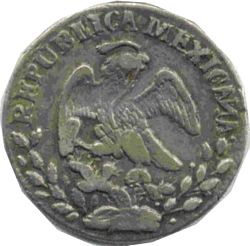
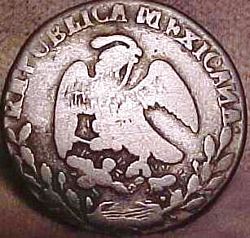
Die 1830 Go E4 Die 1830 Go E6
Die ‘E4’ has a snake going past the ‘I’ in ‘REPUBLICA’’
first oak leaf on wreath almost touches the lower left cactus leaf.
Die ‘E6’ has a snake that ends at the ‘I’ in ‘REPUBLICA’
the top olive leaf touches the ‘A’ in ‘MEXICANA’.
I have not tabulated enough data to tell whether die E4 is any scarcer than die E6.
1830 varieties of retrograde ‘N’ are scarce, and much more difficult to find than they were ten years ago. I used to be able to buy 1830 retrograde ‘N’ reales for $10 to $15 in Fine. Now the price is $40 to $50 each in Fine. People who do not seriously collect other 1 reales will buy one of these when they are encountered because of their novelty.
In 1831 there again were two instances of the use of the retrograde ‘N’, but these represent two very different die styles.
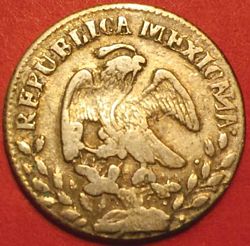
There is a large eagle with a retrograde ‘N’, which is using the same E4 die from 1830. This variety is Very Scarce.
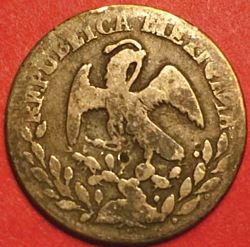
A much rarer, and almost completely unknown variety is the small eagle with the retrograde ‘N’. Catalogs do not differentiate between the two die styles for this date, much less for this error. The variety with the small eagle and the retrograde ‘N’ is Rare to Very Rare. I have only seen three examples. My example is in very low grade, but I would be happy to upgrade if the opportunity ever presents itself.
1834 half real with missing numeral
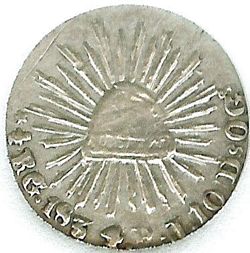
In 1834 a major error was made in a very small number of half real coins. Instead of ‘10D 20G’, the variety has ‘10D 0G’. This error would have had legal significance at the time, and was probably melted whenever it was encountered. This variety appears to be Very Rare. I have only seen two examples for sale in 17 years of collecting. It is missing from the collections of several other half real variety collectors.
1831 and 1832 Half Reales with ‘REPUBIICA’
Varieties of half reales from 1831 and 1832 exist with ‘REPUBLICA’ spelled as ‘REPUBIICA’. Each of these years’ varieties was produced with a different reverse die, which means that the engraver was persistently making the same error on purpose.
Special note must be made about the frequent misattribution of the ‘II’ errors by dealers and collectors. Unless you know what to look for, you may buy a misattributed error because during these years the ‘L’ in ‘REPUBLICA’ sometimes looks like an ‘I’. The ‘II’ error evolved as the narrow ‘L’ was eroded, and old dies were copied. It takes a bit of experience to tell for sure.
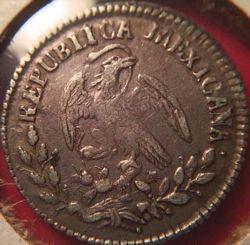
To distinguish a true ‘REPUBIICA’ error from a false one, you have to insure that the ‘II’ are parallel, and exactly the same. In 1831 as dies wore out and were re-engraved, the ‘LI’ starts to morph into an ‘II’. With the above example you do not yet have a true ‘II’, because there is a very slight thin horizontal line on the ‘L’ and the two letters are not completely parallel.

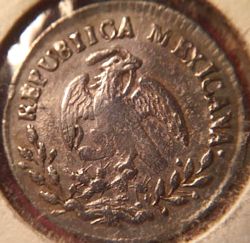
As we will see, a final die in 1831 has a true ‘II’ in ‘REPUBIICA’. The two letters are perfectly parallel and there are no horizontal lines.
The ‘II’ variety also can be found in Reales from 1832 (right above). The 1831 and 1832 ‘II’ errors did not use the same reverse die (the snake on the 1831 ‘II’ goes past the first ‘I’, while the 1832 does not). It seems that both the 1831 and 1832 ‘II’ varieties are Very Scarce to Rare. True examples are hardly ever encountered.
Strong Evidence offered for Illiterate Engraver
The evidence trail starts in 1828 and 1829 when there was use of several dies with an ‘L’ having a thick vertical line, and a thin, short horizontal line. We can see that the 1828/7 MR E1 die is similar to the 1829 MJ E2 die, but not the same. It appears that worn dies were being used as the model when new dies were being created. Note the style of ‘L’ was being used, but its features were becoming washed out.

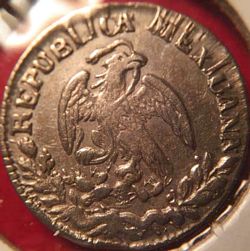
1828/7 MR E1 die 1829 MJ E2 die
In 1830 the E2 die from 1829 was reused, with several of the letters repunched. Note the further erosion of the ‘LI’ letters from what they had been in 1829.

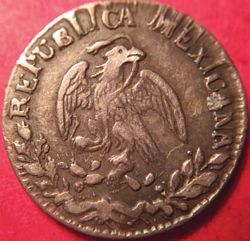
In 1831 there were several ‘L’ punches being used. However, when the above die wore out it appeared to be copied correctly on several occasions. These dies still retain an ‘LI’ but the two letters are more parallel than in 1829 and 1830.
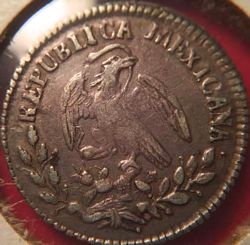
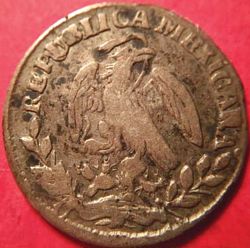
1831/29 MJ, E2 die 1831 MJ, E4 die
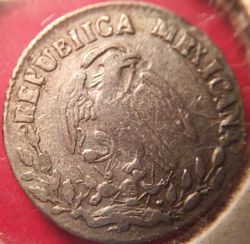
As we will see, a final die in 1831 has a true ‘II’ in ‘REPUBIICA’, when the engraver mistook the ‘L’ for an ‘I’. Because the old die had the ‘LI’ nearly parallel, the new die was produced with the ‘II’ completely parallel. It does not appear that the engraver even knew how to spell ‘REPUBLICA’, and probably had no idea that he had misspelled it.
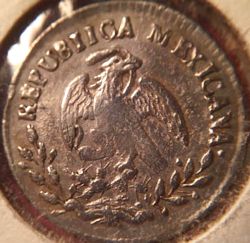
Again in 1832, the ‘II’ die from 1831 must have worn out and was copied to produce a replacement for use in 1832. Close examination of the 1832 die will reveal it to be different from that used in 1831.
Errors are ultimately caught, and in 1832 the error must have been noticed. The new dies that were created had an ‘L’ with an extraordinarily long horizontal line and tail. Apparently the intent was to make sure that the misspelling error would never again occur.
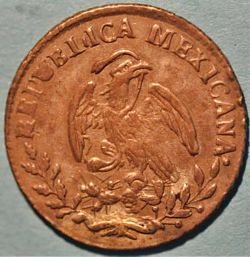
Conclusion
There is something for everyone when collecting minor coins from the period of 1828 thru 1834 in Guanajuato.
- Most coins (in low grade) can be purchased on a small budget because most issues were struck in huge numbers.
- A series of engraving errors exist that are Scarce to Very Rare.
- The possibility exists to discover uncataloged errors.
- Such a collection of errors tells a unique story about a mint operating under primitive conditions.
It is usually during periods of high production that quality control goes out the window. Evidence of die progression in half reales in particular point to the cause of this period of spelling errors being an engraver who was illiterate, or very close to it. Guanajuato had more years of interesting varieties after 1834, but rarely did it have spelling errors. We will never know for certain whether the cause of the spelling errors was illiteracy or alcoholism, but studying the dies makes me think it was an illiterate engraver. The study of the die progressions in this article at a minimum make it plain that engravers in Guanajuato were producing dies of minor coins from worn out dies, rather than drawings or models.
